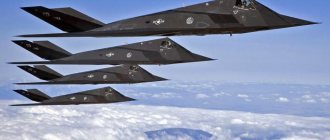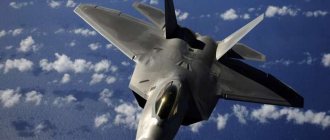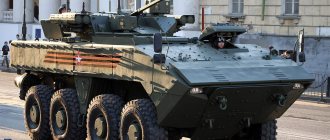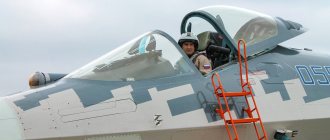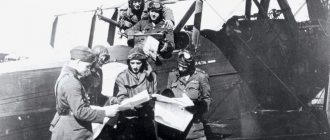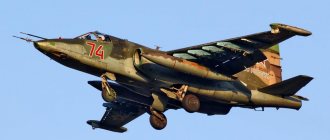The air force has long become the basis of the armed forces of any army. Airplanes are becoming more than just a means of delivering bombs and missiles to the enemy; modern aviation is multifunctional combat systems with wings. The newest F-22 and F-35 fighters, as well as their modifications, have already been put into service with the US Army, and here we mean the “army” as ground forces. This means that infantry is now on a par with tanks and infantry fighting vehicles and includes fighters. This highlights the role of air power in modern warfare. Such a shift towards multifunctionality was made possible by new developments in the field of aircraft construction and changes in the principles of war. A modern fighter can fight without approaching the target closer than 400 km, launch missiles at 30 targets and at the same second turn around and fly to the base. The case is of course a special one, but it more than describes the picture. Not exactly what we are used to seeing in Hollywood blockbusters in which, no matter how far you look into the future, fighters in the air and in space are conducting classic “dog fights” from the times of the Great Patriotic War. Some time ago, a couple of news sites were full of news that in a simulation of the battle between the “drying” and the F-22, the domestic machine emerged victorious due to its superior maneuverability; of course, we were talking about superiority in close combat. All articles noted that in long-range combat the Raptor is superior to the Su-35 due to more advanced weapons and guidance systems. This is what distinguishes 4++ and 5th generations.
At the moment, the Russian Air Force is armed with combat aircraft of the so-called 4++ generation, the same Su-35. This is the product of a deep modernization of the Su-27 and Mig-29, which have been available since the 80s; it is planned to begin a similar modernization of the Tu-160 soon. 4++ means as close as possible to the fifth generation; in general, the modern “drying” differs from the PAK FA in the absence of “stealth” and AFAR. Nevertheless, the possibilities for modernizing this design have basically been exhausted, so the issue of creating a new generation of fighters has been around for a long time.
Fifth generation
Fifth generation of fighters. We often hear this term in the news about modern weapons and at aviation shows. What is it? “Generation” is, in general terms, a list of requirements that modern military doctrine places on a combat vehicle. The 5th generation vehicle should be stealthy, have supersonic cruising speed, advanced target detection systems and electronic warfare systems, but the most important thing is versatility. It’s not for nothing that projects have the word “complex” in their names. The ability to fight equally well in the air and hit ground targets largely determines the appearance of the fifth generation. These are the tasks that were set for the future designers of the new symbol of domestic aviation.
The development of a new generation began in the USSR and the USA almost simultaneously, back in the 80s, and in the States they already selected a prototype in the 90s. Due to world-famous events, the Soviet program found itself in stagnation for many years, which is the reason for the lag in our days. As you know, the 5th generation fighter F-22 Raptor and F-35 Lightning are already in service with the United States and a number of other countries. What is noteworthy is that “Raptors” are not yet supplied even to allies, having noticeable advantages over “Lightnings”, the exclusive presence of “Raptors” in the US Army makes their Air Force the most advanced in the world.
Our response to the Raptors is still being prepared, the dates have been repeatedly postponed, from 2016 to 2017-2018, now it is 2022, but experts say that another postponement is possible, although they note that the new Russian fighter is increasingly taking the form of a finished product every day to mass production.
Tu-204SM
Medium-haul Russian passenger aircraft were replenished with the Tu-204SM in 2010. Immediately after the first flight, serial production of the aircraft was launched in 2011. The modification is distinguished from the basic model by more modern engine equipment, a comfortable interior, and it has dramatically improved its condition. Reliability and durability remained the same, it was unlikely that this needed to be changed. The car was created to transport passengers, and it has quite good capacity for 194 passengers.
- Length: 46.2 m
- Height: 13.88 m
- Wingspan: 41.8 m
- Capacity: 194 people.
- Speed: 850 km/h
Su-47 "Berkut"
In Russia, the fifth generation has a rather long-suffering history. As you know, the PAK FA, also known as the T-50, and more recently the Su-57, is not the first attempt to get an ultra-modern multi-role fighter into service. One of these attempts was the Su-47, also known as Berkut. Testing of a new aircraft with a forward-swept wing took place back in the 90s. The car is very memorable and has been in sight and hearing for a long time. The “reverse” wings partly played a cruel joke on him. Such a design brought the aircraft to a new level of maneuverability, however, to solve all the problems of such a design, the forces were never found, either in Russia or in the States, where in the 80s there was a project for the X-29, a fighter with a similar swept wing. Also, this prototype did not meet all the requirements of the fifth generation, for example, it could only overcome supersonic power with afterburner.
Only one fighter was built and it is now used only as a prototype. Perhaps the Su-47 will be the last attempt to create an aircraft with a forward-swept wing.
Tu-214
Let's try to remember which Russian aircraft were developed in the USSR, but even today continue to fly. For example, the Tu-214 is an excellent example; it flies at medium distances and is a deep modernization of the Tu-204-100. Compared to its predecessor, this variant received improved flight range and increased take-off weight. Today they fly at a maximum distance of 5,000 kilometers. It is included in Russian passenger aircraft that have certificates for flights to other countries of the world, which means it meets all the criteria. Everything in the cabin looks spacious, there are shelves for cargo, a fully illuminated space, there is a multimedia system for entertaining passengers and, of course, they have taken care of maintenance.
- Length: 46 m
- Height: 13.90 m
- Wingspan: 42 m
- Capacity: 210 people.
- Speed: 850 km/h
Su-57 (PAK FA)
PAK FA (Advanced Aviation Complex of Frontline Aviation) is a new Russian aircraft. It became the first successful attempt to bring to life the fifth generation of aircraft. At the moment, there is little information in the public domain about its characteristics. From the obvious, it has all the characteristics of the fifth generation, namely supersonic cruising speed, stealth technologies, active phased array antennas (AFAR), and so on. Externally, it is similar to the F-22 Raptor. And now everyone who is not too lazy is already starting to compare these machines, no wonder, because the Su-57 will become the main “protagonist” in the fight against the Raptors and Lightnings. It is worth noting that in the new realities, the improvement of missiles will also occupy a special place. As has already been said, entering into battle takes place over gigantic distances, so how maneuverable a fighter will be and how well it feels in close combat is a matter of minor importance.
In Russia, the “arrows” for the latest aviation technology are the R-73 rocket and its modifications, which rightfully bear the fame of a formidable weapon. But the designers, in accordance with the good Russian tradition, “just in case”, provided for the installation of a 30-mm air cannon on the Su-57.
Sukhoi Superjet 100
It is one of the best Russian civil aircraft that fly short distances, and it carries no more than 108 passengers per flight. The creators of air transport are engineers from Komsomolsk-on-Amur. The Sukhoi Superjet 100 made its first flight in 2008 and entered service in 2011. Currently, 207 units of this aircraft have been built to transport people. There are already many orders abroad.
- Length: 29.94 m
- Height: 10.28 m
- Wingspan: 27.8 m
- Capacity: 108 people.
- Speed: 950 km/h
In developing
Another transition to the “five” is planned for another 4++ aircraft - the Mig-35. Sketches of the “face” of the future interceptor have already been shown, but it is not yet clear whether there will be a need for it or whether the Su-57 will cope with its functions. Not only would a light fighter meet all the requirements of the new generation, it would be necessary to develop a fundamentally new engine and solve the problem of installing stealth. Which is impossible for cars of this class in modern realities. As mentioned earlier, the fifth generation assumes the multifunctionality that the Su-57 should theoretically have, so what tasks will be assigned to the Mig is still not clear.
Another promising vehicle for the Russian aviation forces is the PAK DA, being developed within the walls of the Tupolev design bureau. From the abbreviation it is clear that we are talking about long-range aviation. According to the plan, the first flight is in 2025, but given the tendency to postpone the release of anything, you can immediately throw in a couple of three, or even five years. Therefore, most likely we will not soon see the new Tupolev take off into the sky; obviously, long-range aviation will make do with the Tu-160 and its modification in the near future.
Serial light ekranoplan "Aquaglide-5"
What's the trick: a surprisingly economical and high-torque light ship-plane
The position of ekranoplanes in the classification of technical means is still difficult to determine: either low-flying aircraft or ships hovering over the water. The airfoil effect produces lift under the wing, but operates at a limited altitude.
This force is higher than that of airplanes, and allows serious savings on fuel. The mass-produced marine ekranoplan Aquaglide-5 surprises with its characteristics, which do not fit in with its compact dimensions.
With a total mass of 2400 kilograms, the device reaches speeds of up to 150 kilometers per hour and is capable of “flying” over distances of up to 400 km, while consuming only 120 kilograms of fuel .
A similar aircraft would require three times as much. True, they do not fly such distances. And for the Aquaglide there is an important characteristic of seaworthiness: its operation is possible only with a wave height of no more than 35 centimeters.
However, like other ekranoplanes, the product of the Arctic Trade and Transport Company can move over any flat surface. A highway a little more than 6 meters wide, a flat field, and even an ordinary plain without deep unevenness (no more than 30 centimeters ) are suitable.
The device is designed to carry 4 passengers, and any car enthusiast can “pilot” it after a little training.
Sixth generation
On the Internet, no, no, yes, there is a yellow article about the sixth generation of fighters. That development is already in full swing somewhere. This is of course not true, because let us remind you that the newest fifth generation is in service only with the United States. Therefore, it is too early to talk about “development at full speed.” I should finish with the fifth one here. As for speculation about what the weapons of the future will look like, there is room for discussion. What will the new generation of aircraft be like?
From the sixth generation we can expect that all standard characteristics will increase. Speed, maneuverability. Most likely, the weight will decrease, thanks to new materials of the future, electronics will reach a new level. In the coming decades, we may expect breakthroughs in the creation of quantum computers; this will allow us to move to an unprecedented level of computing speed, which in turn will make it possible to seriously modernize the modern AI of the aircraft, which in the future may rightfully bear the name “co-pilot.” Presumably, there will be a complete abandonment of the vertical tail, which is absolutely useless in modern realities, since fighters operate mainly at extreme and extreme angles of attack. This could lead to interesting airframe shapes, perhaps again an attempt to change the wing sweep.
The most important question that future designers will decide is whether a pilot is needed at all? That is, will the fighter be controlled by AI or by a pilot, and if by a pilot, will the pilot control the plane remotely or the old-fashioned way from the cockpit. Imagine a plane without a pilot. This is a huge “relief” for the car, because in addition to the weight of the pilot himself and his equipment, a decent load is created by the pilot’s seat, which is supposed to save lives, which makes it a complex machine, stuffed with electronics and mechanisms for ejecting the pilot. Not to mention changing the design of the airframe, in which there is no need to allocate a huge amount of space for a person and rack your brains over the ergonomic design of the cockpit to make it easier to control the machine in the air. The absence of a pilot means that you no longer need to worry about overloads, which means the car can be accelerated to any speed that the structure can handle, the same goes for maneuvers in the sky. This will also make pilot training easier. And we are talking not only about reducing the requirements for the pilot’s health. Now the pilot is the most valuable thing in a fighter aircraft. Enormous amounts of time and resources are spent on preparation; the loss of a pilot is irreplaceable. If a pilot controls a fighter from a comfortable chair deep in a bunker on a military base, then this will change the face of war no less than the “transfer” from horses to tanks and infantry fighting vehicles.
The prospect of completely eliminating the pilot still looks like a task for the more distant future. Scientists are warning about the consequences of using AI, and the very philosophical and ethical component of replacing a person with a robot in war is still being studied. We still do not have the computing power to create a full-fledged replacement for the pilot, but in the coming decades a technological revolution in this area is possible. On the other hand, the pilot's flair and military ingenuity cannot be recreated by zeros and ones. For now, these are all hypotheses, so the appearance of modern aviation and the air force of the near future will still have a human face.
The fastest production fighter MiG-31BSM
What's the big deal: the fastest combat aircraft
Although the first modifications of the MiG-31 began to enter service back in 1980, modern modifications of this heavy fighter can be confidently called Russian.
As a result of deep modernization, engineers managed to retrain the interceptor, designed to destroy exclusively air targets, into a multi-role aircraft for conducting combat operations against any targets, including ground ones.
The 46-ton colossus outperforms most existing combat aircraft, accelerating up to 3,400 kilometers per hour . At the same time, the cruising speed (constant movement without afterburner) of the MiG-31 is 2500 kilometers per hour.
In contrast, most combat fighters are designed for long flights at subsonic or transonic speeds, and break the sound limit briefly, to reach a target or during combat.
The MiG-31BM rises to an altitude of up to 35 kilometers , outperforming lighter competitors in this parameter as well. He also set a record for supersonic flight duration, which was 7 hours.
And all this despite the fact that the plane is larger in size than many bombers. Can you tell from this angular car that it is a thunderstorm with a hypersonic missile under the fuselage and a range of “arms” of 2 thousand kilometers ?

